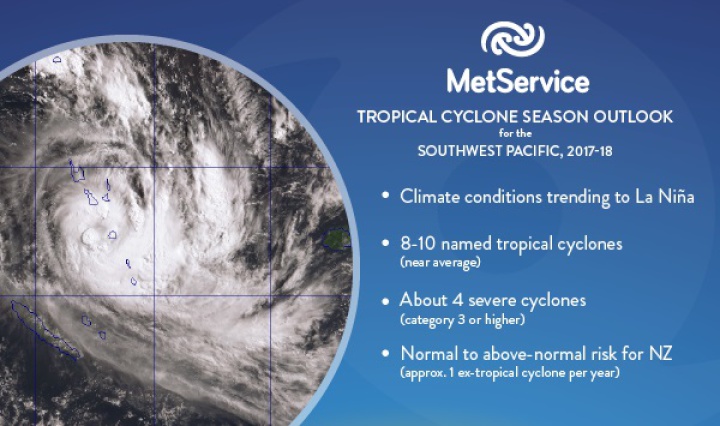Tropical Cyclone activity expected to be near-normal
11 October 2017
Tropical
Cyclone activity expected to be near-normal this
season
The Southwest Pacific tropical cyclone season formally starts on the 1st of November, with an average number of named cyclones expected in the upcoming 2017-18 season under the influence of climate conditions heading into La Niña this summer.
Every year MetService works alongside NIWA and national meteorological services from other Pacific nations to produce a Tropical Cyclone Outlook for the upcoming season. The outlook for the 2017-18 season indicates 8 to 10 named cyclones are expected in the Southwest Pacific, with about 4 of those expected to be severe (Category 3 or higher). The average number of named tropical cyclones in the Southwest Pacific (including the Coral Sea) is about 10 per season.
This year, with the El Nino Southern Oscillation (ENSO) cycle tending to La Nina conditions, tropical cyclone activity is expected to be higher than normal around the Coral Sea and west of the International Date Line, and lower further east. For New Zealand, which is affected by about one ex-tropical cyclone on average per season, the risk is expected to be normal to slightly above normal.
Around the globe, the role of
monitoring and warning for tropical cyclones is performed by
a WMO designated Regional Specialized Meteorological Centre
(RSMC) or a Tropical Cyclone Warning Centre (TCWC),
depending on the location of the cyclone. TCWC Wellington,
based at MetService, has warning responsibility for the area
that extends from 160E to 120W between 25S and 40S. Although
it is very rare for a tropical cyclone to form in the TCWC
Wellington area of responsibility, intense tropical cyclones
do arrive from the neighbouring Brisbane or Nadi areas and
they often retain their named cyclone status until near 30S.
Sometimes an ex-tropical cyclone will approach New Zealand
and the official Severe Weather Watches and Warnings need to
be issued by MetService. Even if land areas are not
affected, warnings are still issued for vessels over the
open sea.

Although the tropical cyclone season typically runs from the start of November until the end of April, cyclone development doesn’t always follow the calendar and cyclones can form outside the season. All communities throughout the South Pacific, including New Zealand, are encouraged to prepare for the coming cyclone season and remain vigilant for developing cyclones or other severe weather. You can keep up to date with current and expected tropical cyclone activity on the MetService website at http://info.metraweather.com/e/60812/ings-tropical-cyclone-activity/f5m1l6/612683765 where a TC Potential Bulletin will be issued daily from 1st November, or earlier if necessary.
ends


 Netsafe: Statement From Netsafe About Proposed Social Media Ban
Netsafe: Statement From Netsafe About Proposed Social Media Ban The Reserve Bank of New Zealand: 2024 General Insurance Stress Test Results Published Today
The Reserve Bank of New Zealand: 2024 General Insurance Stress Test Results Published Today  Worldline: School Holidays And Long Weekends Change Regional Spending Patterns In April
Worldline: School Holidays And Long Weekends Change Regional Spending Patterns In April Stats NZ: Livestock Numbers Fall Over The Last 10 Years While Area Planted In Fruit Increases
Stats NZ: Livestock Numbers Fall Over The Last 10 Years While Area Planted In Fruit Increases Moths and Butterflies NZ Trust: Tagged Monarchs Found
Moths and Butterflies NZ Trust: Tagged Monarchs Found Master Plumbers Gasfitters and Drainlayers NZ: 2025 New Zealand Plumbing Conference Awards - Full List Of Winners
Master Plumbers Gasfitters and Drainlayers NZ: 2025 New Zealand Plumbing Conference Awards - Full List Of Winners